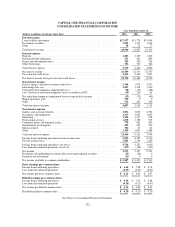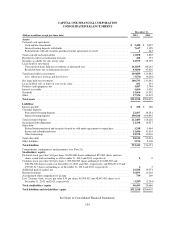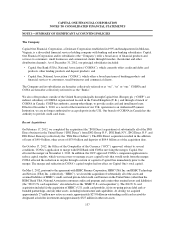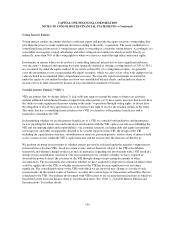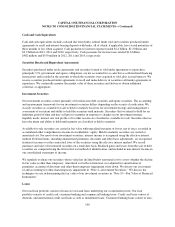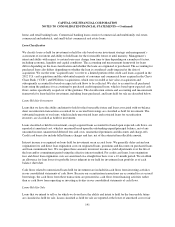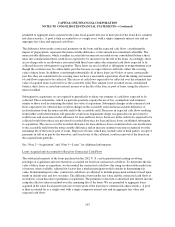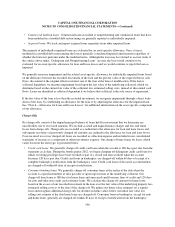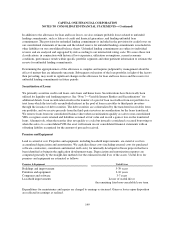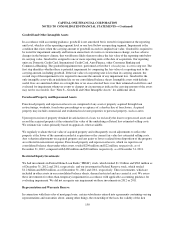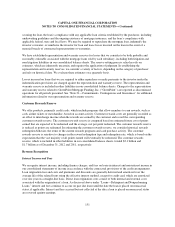Capital One 2012 Annual Report Download - page 160
Download and view the complete annual report
Please find page 160 of the 2012 Capital One annual report below. You can navigate through the pages in the report by either clicking on the pages listed below, or by using the keyword search tool below to find specific information within the annual report.CAPITAL ONE FINANCIAL CORPORATION
NOTES TO CONSOLIDATED FINANCIAL STATEMENTS—(Continued)
home, and retail banking loans. Commercial banking loans consist of commercial and multifamily real estate,
commercial and industrial, and small-ticket commercial real estate loans.
Loan Classification
We classify loans as held for investment or held for sale based on our investment strategy and management’s
assessment of our intent and ability to hold loans for the foreseeable future or until maturity. Management’s
intent and ability with respect to certain loans may change from time to time depending on a number of factors,
including economic, liquidity and capital conditions. The accounting and measurement framework for loans
differs depending on the loan classification and whether the loans are originated or purchased. The accounting for
purchased loans also differs depending on whether the loan is considered credit-impaired at the date of
acquisition. We use the term “acquired loans” to refer to a limited portion of the credit card loans acquired in the
2012 U.S. card acquisition and the substantial majority of consumer and commercial loans acquired in the Chevy
Chase Bank (“CCB”) and ING Direct acquisitions, which were recorded at fair value at acquisition and
subsequently accounted for based on expected cash flows to be collected. We elect to account for all purchased
loans using the guidance for accounting for purchased credit-impaired loans, which is based upon expected cash
flows, unless specifically scoped out of the guidance. The classification criteria and accounting and measurement
framework for loans held for investment, including loans purchased, and loans held for sale are described below.
Loans Held for Investment
Loans that we have the ability and intent to hold for the foreseeable future and loans associated with on-balance
sheet securitization transactions accounted for as secured borrowings are classified as held for investment. The
substantial majority of our loans, which include unrestricted loans and restricted loans for securitization
investors, are classified as held for investment.
Loans classified as held for investment, except acquired loans accounted for based upon expected cash flows, are
reported at amortized cost, which is measured based upon the outstanding unpaid principal balance, net of any
unearned income, unamortized deferred fees and costs, unamortized premiums and discounts and charge-offs.
Credit card loans also include billed finance charges and fees, net of the estimated uncollectible amount.
Interest income is recognized on loans held for investment on an accrual basis. We generally defer certain loan
origination fees and direct loan origination costs on originated loans, premiums and discounts on purchased loans
and loan commitment fees. We recognize these amounts in interest income as yield adjustments over the life of
the loan and/or commitment period using the effective interest method. For credit card loans, loan origination
fees and direct loan origination costs are amortized on a straight-line basis over a 12-month period. We establish
an allowance for loan losses for probable losses inherent in our held for investment loan portfolio as of each
balance sheet date.
Cash flows related to unrestricted loans held for investment are included in cash flows from investing activities
in our consolidated statements of cash flows. Because our securitization transactions are accounted for as secured
borrowings, the cash flows from these transactions are presented as cash flows from financing activities rather
than as cash flows from operating or investing activities in our consolidated statements of cash flows.
Loans Held for Sale
Loans that we intend to sell or for which we do not have the ability and intent to hold for the foreseeable future
are classified as held for sale. Loans classified as held for sale are reported at the lower of amortized cost or fair
141



